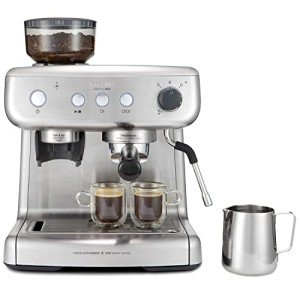10 Reasons Why People Hate Bean To Cup Espresso Machines Bean To Cup Espresso Machines
The Rise of Automatic Espresso Machines: A Comprehensive Guide
Espresso, a foundation of coffee culture worldwide, has traditionally required a particular level of ability and proficiency to prepare. Nevertheless, the arrival of automatic espresso machines has actually changed the way coffee lovers and casual drinkers enjoy their daily espresso shots. With convenience, precision, and ease of use at the forefront, these machines are becoming progressively popular in homes and coffee shops alike. This short article checks out the functions, advantages, and factors to consider of automatic espresso machines, together with a useful FAQ area.
Comprehending Automatic Espresso Machines
Automatic espresso machines automate the espresso-making process, allowing users to brew high-quality coffee with minimal effort. These devices normally include integrated mills, programmable settings, and several functions that improve user experience. Let's dive deeper into the components and benefits of these machines.
Key Features of Automatic Espresso Machines
Integrated Grinder
- Many automatic machines come equipped with a grinder, allowing users to enjoy newly ground coffee beans for each brew. This function ensures optimum flavor and scent.
Programmable Settings
- Automatic espresso machines typically consist of programmable options for shot size, milk frothing, and brewing temperature level. Users can customize their coffee experience according to individual choices.
Milk Frother
- For those who enjoy coffees or lattes, a quality milk frother is necessary. Many machines included built-in frothing abilities or steam wands, allowing users to produce velvety, textured milk foam.
User-Friendly Interface
- A lot of automatic espresso machines include user-friendly interfaces with touchscreens or buttons, simplifying the brewing process. Users can quickly browse through numerous settings and alternatives.
Self-Cleaning Functionality
- Cleaning up an espresso machine can be laborious, but many automatic models offer self-cleaning features, ensuring ease of upkeep and constant coffee quality.
Benefits of Using Automatic Espresso Machines
Automatic espresso machines bring significant benefits compared to traditional manual techniques. Here are some of the essential benefits:
- Convenience: With programmable features and one-touch operation, preparing a perfect cup of espresso has actually never ever been simpler.
- Consistency: Automatic machines supply a constant brewing procedure, guaranteeing each cup of coffee meets the user's expectations.
- Time-Saving: With fast heat-up times and fast developing cycles, users can enjoy their coffee without prolonged preparation.
- Quality: Many high-end automatic espresso machines provide the same quality as professional barista-made espresso, thanks to sophisticated developing technologies and high-quality elements.
Popular Brands and Models
When exploring the market for automatic espresso machines, several brand names and designs stand apart. Here's a quick introduction of some top choices:
Brand
Design
Secret Features
Price Range (GBP)
De'Longhi
Magnifica S
Integrated grinder, personalized settings
₤ 500 – ₤ 700
Breville
Barista Express
Integrated grinder, steam wand, PID control
₤ 600 – ₤ 800
Siemens
EQ.9
Automated cleaning, dual bean hoppers
₤ 1,000 – ₤ 2,000
Jura
E8
Smart pre-heating, AromaG3 grinder
₤ 1,200 – ₤ 1,900
Gaggia
Anima
Compact style, milk frothing included
₤ 500 – ₤ 800
Elements to Consider When Purchasing an Automatic Espresso Machine
Before making a purchase, possible buyers ought to consider different factors:
Budget
- Identify your budget, as costs can differ substantially depending on functions and brand name.
Size and Design
- Think about the offered space in your cooking area. Some machines are compact, while others might need more counter area.
User Experience
- Look for machines that offer easy to use interfaces and customizable options, specifically if multiple users will operate the machine.
Maintenance
- Automatic machines can require different cleansing and maintenance regimens. It's essential to pick one that lines up with your willingness to preserve it.
Guarantee and Customer Support
- Examine the guarantee offered by the maker and their consumer support track record. This can be crucial if you experience any problems.
Regularly Asked Questions (FAQs)
1. How do I look after my automatic espresso machine?
Taking care of your automatic espresso machine includes routinely cleaning the removable parts, running descaling cycles as required, and guaranteeing that the grinder is free of coffee accumulation.
2. Are automatic espresso machines worth the price?
Yes, for coffee lovers and those seeking convenience and consistency, automatic espresso machines are often worth the investment. They supply high-quality coffee with very little effort.
3. Can Best Espresso Machines use pre-ground coffee in an automatic espresso machine?
Some automatic espresso machines enable the use of pre-ground coffee, while others are designed for fresh beans. Constantly check the machine's requirements.
4. What is the difference between a semi-automatic and an automatic espresso machine?
Semi-automatic machines need the user to control the brewing process, while automatic machines automate this procedure, making them simpler to use.
5. The length of time do automatic espresso machines last?
With appropriate care and upkeep, a high-quality automatic espresso machine can last anywhere from 5 to 15 years.
Automatic espresso machines are a great addition to any coffee enthusiast's kitchen area. With their ingenious features and user-friendly styles, they provide the perfect balance of convenience and quality. Whether right here 're a home barista or simply someone who delights in an excellent cup of coffee, purchasing an automatic espresso machine can raise your coffee experience to the next level. As technology continues to develop, these machines will likely end up being much more advanced, making espresso more available to all.
